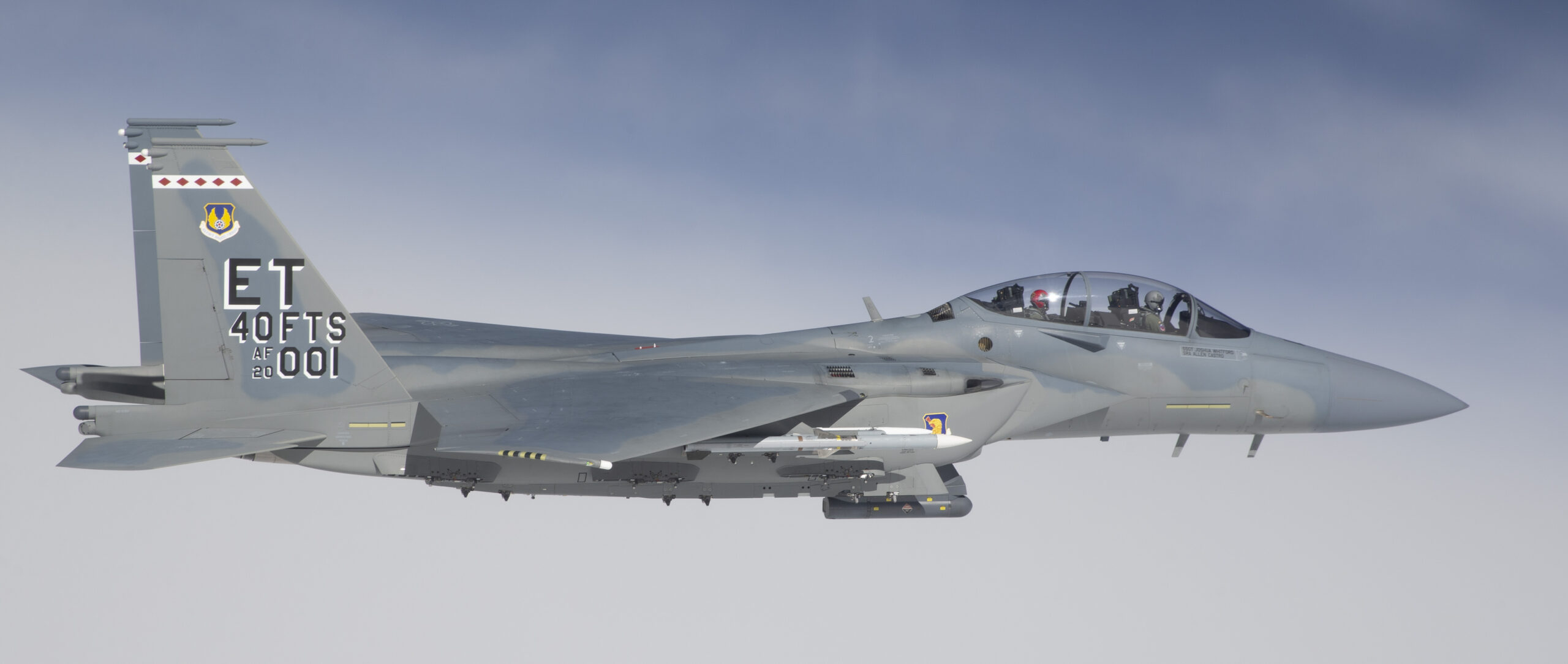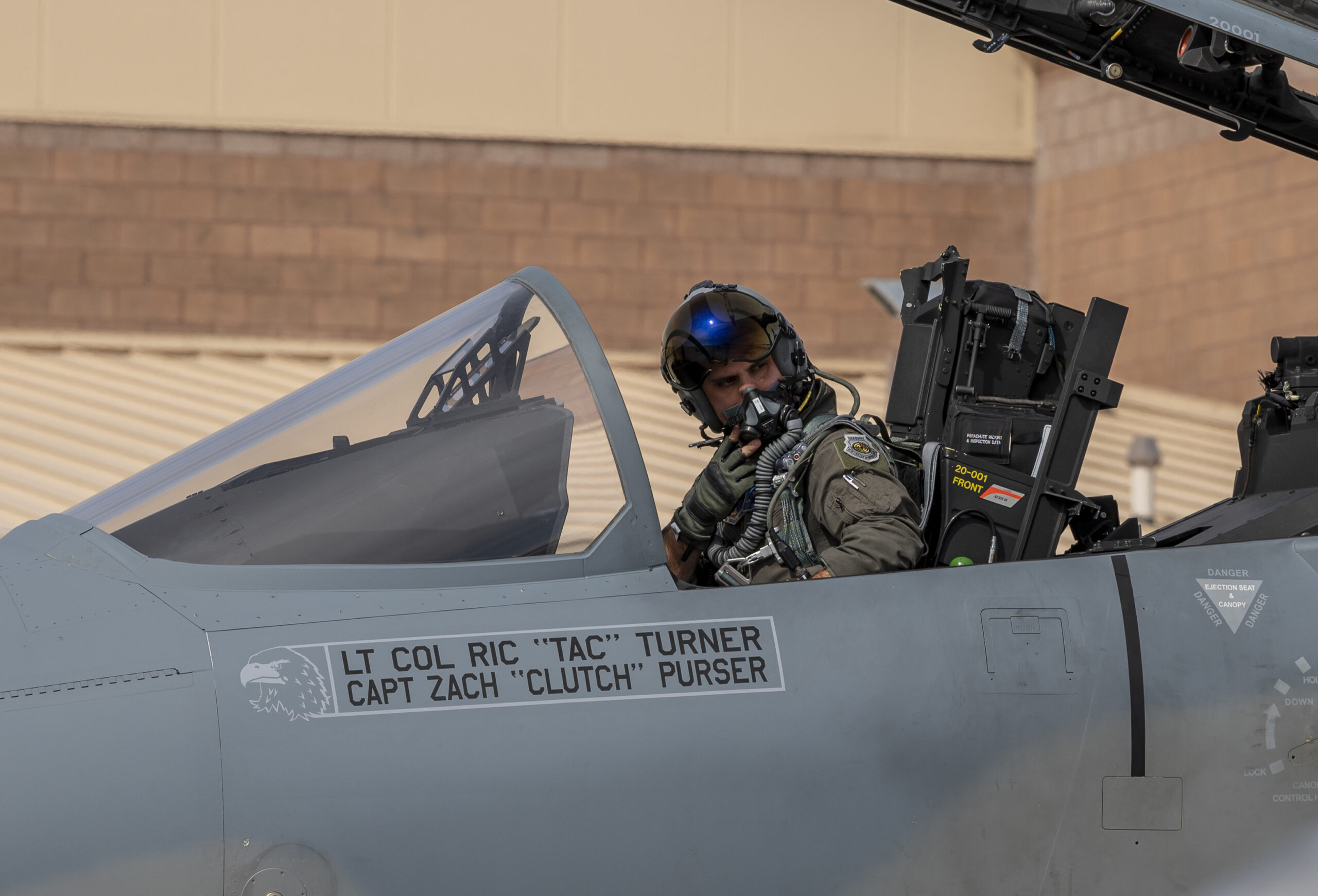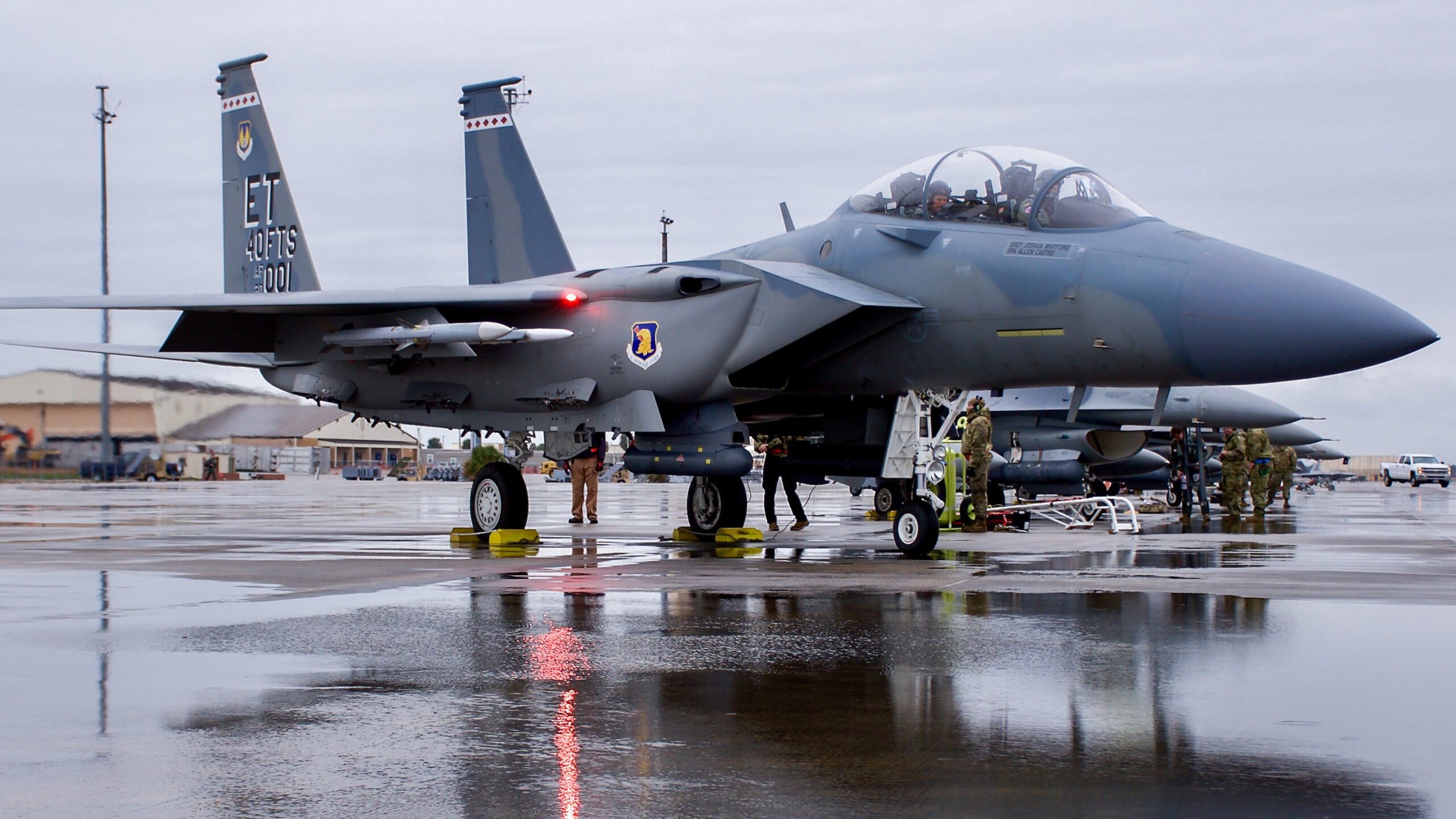Officials within the U.S. Air Force are examining options for canceling the service’s new F-15EX Eagle II fighter, a type that was only accepted into the inventory a little over a year ago, after buying just 80 examples. In what would be a remarkable turnaround, should it happen, the capping of the F-15EX fleet would be good news for the F-35A stealth fighter, procurement of which is currently being slowed to ensure more funds for the initial Eagle II buys. The War Zone originally broke the F-15EX story in 2018.
In its budget request for Fiscal Year 2023, the Air Force has reduced its expected overall F-15EX purchase to 80 aircraft, after originally saying it would buy at least 144 to replace its aging F-15C/D Eagles and perhaps also to supplant its F-15E Strike Eagles. If the service does follow through on this new plan, the final Eagle II would be purchased in Fiscal Year 2024.

A suggestion that the Air Force officials might be looking at trimming the overall F-15EX buy came late last month. Valerie Insinna of Breaking Defense reported that “two sources with knowledge of the matter” had confirmed that Secretary of the Air Force Frank Kendall had tasked the service’s budget corps to consider canceling the F-15EX.
In the short term, however, the F-15EX is safe. The Fiscal year 23 budget request calls for F-35A procurement to be trimmed back — 33 aircraft as opposed to 48 in Fiscal Year 2022. At the same time, the latest proposed budget includes 24 F-15EX jets, worth a total of $1.4 billion. The previous budget for the 2022 fiscal cycle request covered 12 Eagle IIs.
The current plan is somewhat more complex than simply striking the F-15EX off the order books after these 80 aircraft have been bought. Instead, according to the sources, Eagle II acquisition numbers will be ramped up in the short term, before ending prematurely in favor of buying more F-35As in the more capable and deeply updated Block 4 configuration, something you can read more about here.

This plan would concentrate on replacing the F-15C/D air superiority jets as fast as possible, over a period of around five years, after which focus would return to the F-35A.
As it stands, the Pentagon is still in talks with Lockheed Martin over the next F-35 production lot, likely to amount to around 400 examples. With the Block 4 update behind schedule, the U.S. F-35A procurement rate has had to be slowed down, for now at least.

At this point, it’s worth noting that an 80-aircraft cap on F-15EX orders for the Air Force is, currently, just a proposal. Congress would have to approve it as part of the larger defense budgeting process. Trimming numbers from the planned minimum of 144-aircraft buy will almost certainly face stiff opposition, not just from Congress, but also from supporters of the Eagle II within the Air Force and the Pentagon, as well as industry.
There’s also the very real question of how a reduced-size F-15EX fleet would be integrated within the Air Force. It seems unfeasible that it would not result in major changes to the current plans of fielding the Eagle II.
As it stands, testing of the F-15EX is underway at Eglin Air Force Base in Florida. Aircraft are due to be delivered to the Oregon Air National Guard’s 173rd Fighter Wing, the United States’ only F-15C/D training unit, based at Kingsley Field, in the 2024 Fiscal Year. The following year, the 142nd Fighter Wing, another Oregon Air National Guard unit, at Portland Air National Guard Base, is slated to become the first operational unit to fly the jet in Fiscal Year 2025.

Responsible for 93 percent of all homeland defense missions, the Air National Guard was largely expected to recapitalize all its F-15C/Ds with either F-15EX or F-35A jets — although F-16s were discussed for a period — the precise balance of which is yet to be disclosed.
While Active Component (AC) fighter squadrons may have around 24 Primary Assigned Aircraft (PAA), that number is smaller — around 18 per squadron — for the Air National Guard. The latter, right now, is the primary operator of the F-15C/D. If just 80 examples of the F-15EX are acquired, then even with 18 PAAs, and three more in backup inventory, it would not be able to equip four squadrons, especially given maintenance demands and ongoing tests duties are factored in. Once you add in the schoolhouse for training, you are left with, at the very best, three actual combat-coded squadrons, and even that would be a stretch.
The Air National Guard could always try and shrink the squadron size with the justification that the new EX is far more reliable than the geriatric C/D models, but that could only be by a few jets or so. It could also be an issue considering the homeland defense duties these squadrons are assigned to, which we will discuss more in a moment.
At RAF Lakenheath in Europe, one squadron of the 48th Fighter Wing is already converting from the F-15C/D to the F-35A. The 125th Fighter Wing, part of the Florida Air National Guard, is also due to swap its F-15C/D Eagles for F-35As in what was a curious move and possibly a sign of what’s to come.

Still, that leaves the Pacific Air Forces’ 18th Wing at Kadena Air Base, Okinawa, with two squadrons, the 104th Fighter Wing of the Massachusetts Air National Guard, the 144th Fighter Wing of the California Air National Guard, and the 159th Fighter Wing of the Louisiana Air National Guard all flying F-15C/Ds with one squadron each. This is in addition to the 173rd Fighter Wing and 142nd Fighter Wing in Oregon. Something would have to give if only 80 F-15EX jets are acquired, with perhaps only one or two other wings being outfitted, after the two Oregon ANG units.
As for Kadena, that strategically important base has already been earmarked as a preferred F-15EX recipient, by the head of Pacific Air Forces, Gen. Kenneth Wilsbach. Last month, Wilsbach said he wanted to see the Eagle II replacing the two squadrons of F-15C/Ds currently operated from the Okinawa base.
“What we intend to use it for there, if we’re so fortunate to get that replacement, is air superiority and some long-range weapons capabilities that you can conduct on the F-15EX,” Wilsbach explained at a Mitchell Institute for Aerospace Studies event in March.
Indeed, with 80 F-15EX aircraft in the Air Force, it’s conceivable that, instead of a one-for-one F-15C/D replacement, the Eagle II would instead start to be employed as a more specialist fleet.
This is something that Air Force officials are also increasingly referring to.
Speaking to Air Force Magazine recently, Lt. Gen. David S. Nahom, the Air Force’s deputy chief of staff for plans and programs, said that he expected the F-15EX to “carry similar weapons” and be used in a way that was “pretty comparable” to the F-15E. That suggests a much more air-to-ground-oriented mission set for the Eagle II, in a clear break from the F-15C/D.

Furthermore, Nahom talked about the F-15EX’s “ability to carry some outsize weapons that you [wouldn’t] necessarily put internal into a fifth-gen airplane,” which has long been an argument for the type. That, in turn, points to the Air Force increasingly viewing the F-15EX in terms of its potential to carry large air-to-air weapons, or larger air-to-ground weapons, including hypersonic ones, that wouldn’t necessarily fit in the internal weapons bays of stealth fighters like the F-35A and couldn’t be efficiently carried under their wings.
Admittedly, Nahom also discussed the F-15EX’s range and weapons-load advantages in the context of longer-duration air defense missions in permissive areas. Maybe most ominously, Nahom stated, “We don’t need a large fleet of them. And I think you’ll see in our budget, we’re not going after a large fleet.”
What’s also confusing is that the Air Guard F-15C/D units have the aforementioned homeland defense role, which sucks up a lot of resources both in terms of training, manpower, and needing aircraft to sit alert around the clock. The latter usually includes at least three to four airframes being set aside for the mission at any given time. Considering a good amount of aircraft are also going through deep maintenance, you can see how a squadron’s available fleet of aircraft begins to look much smaller in reality than the 18 primary and three backup aircraft formally assigned.
Another factor, of course, is the Next Generation Air Dominance program, or NGAD, for which the Air Force requested $1.65 billion in funding under the proposed Fiscal Year 2023 budget, around $133 million more than in the Fiscal Year 2022 requset. While NGAD is much more than a conventional fighter, it will be expected to spearhead the Air Force’s tactical air dominance capabilities, via a broad ‘system of systems’ approach in the decades to come. With that in mind, scaling back F-15EX numbers to concentrate on the F-35A as the backbone of the tactical fleet, after which the NGAD would hopefully come online, seems to be the gamble the Air Force is trying to take. Congress is already questioning this rationality.
This plan doesn’t address the homeland defense mission, unless using ‘exquisite’ 5th or 6th generation aircraft that run at a high cost for that work, which does not require their stealthy capabilities, is the route the USAF really wants to go. Also, this doesn’t solve the outsized weapons issue, at least as far as we know. Using the main platform under development as part of the NGAD program to lug around standoff weapons seems highly counter-productive.

Talking about budget choices recently, Air Force Secretary Kendall explained: “We needed to fully fund the Next-Generation Air Dominance platform. We wanted to complete the buy of the F-15EX, which has a couple more years to go now.”
In the competition for funds, there are other major rivals to the F-15EX and F-35A, as well, chiefly the hugely expensive efforts to develop the new B-21 Raider stealth bomber, next-generation unmanned systems, and the nuclear recapitalization program, among others.
Once again, the ultimate size of the F-15EX fleet is to be determined and it’s possible that the Air Force might end up having to stick to the previously announced 144-plus aircraft. How the Eagle II fares on the export market could also be a factor, with the possibility of a longer production run to satisfy foreign operators perhaps giving the Air Force an opportunity to boost F-15EX numbers further down the line.
For the Air Force, a run of just 80 aircraft creates a minuscule fleet that doesn’t seem worth the trouble it creates, especially in terms of requiring a dedicated schoolhouse and test and development enterprise, and much more. At the very least, equipping the remaining F-15C/D Air National Guard units and the schoolhouse, five squadrons in total, always seemed like a ‘critical mass’ for the program. Adding the two active-duty squadrons in Okinawa, would make seven.

Finally, there is an argument to be made for re-equipping the Hawaii Air National Guard with the F-15EX, which is far better suited for the mission of protecting the highly strategic island chain than the F-22. This would allow for further consolidation of the shrinking F-22 force, which is an ongoing initiative that you can read about here. This would put the total run at roughly around 180 airframes, based on our calculations. But doing so would also provide a solution for a very long time — the F-15EX has an airframe life of 20,000 hours compared to 6,000-8,000 hours on most fighter aircraft — for the homeland defense mission. The F-15EX was originally seen as a way to inject diversified stability into the USAF’s fighter fleet, both in terms of reliability, cost per flight hour, age, and longevity.
There is also the question of the F-15E, which is now middle-aged. As we have floated before, would it make sense to buy a couple hundred F-15EXs to replace the F-15E fleet in the active force, and take the F-15Es and equip Air National Guard squadrons with them? From what we know, this has never been discussed publicly but seems like a glaringly logical option.
The biggest oddity here is that the Air Force, which has long lamented operating small fleets of aircraft, has turned to this concept as the default financial and force structure strategy recently. The B-1B fleet was shrunk, the F-22 fleet is requested to be shrunk, so is the A-10 fleet, among others. While this may result in comparatively small amounts of money to be spent elsewhere and acts as a spare parts bin for supporting the remaining fleet for a period of time, it also results in a steep decline in return on investment for each of these fleets and limits the potential combat mass available at any given time. The fact that the Air Force is now looking to do this with so many of its legacy types, it may not be all that surprising that the F-15EX is being birthed directly into this reality. As a result, the question becomes, does it make sense to keep the type at all? Or in the F-15EX’s case, to procure the aircraft in any numbers?
Maybe, in the end, forcing that question is the Air Force’s real goal.
Contact the author: thomas@thedrive.com
